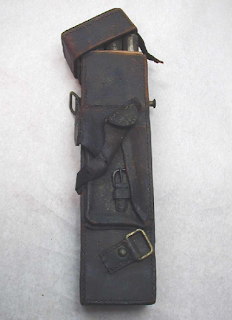Armed conflicts often produce prime
opportunities for new inventions to emerge and technology to evolve. Many new
developments come as the result of previous advances. While some innovations—like
those medical in nature—ultimately improve lives, an unfortunate result, too,
is that many wartime ideas lead to more effective ways to kill or maim. The
American Civil War provides numerous examples of both. During the war,
inventors claimed patents on everything from filter canteens to ironclad ships.
However, weaponry, both large and small, was one of the most fertile fields for
innovative thinking when the United States and Confederate State came to blows.
In the collections of Pamplin Historical
Park and the National Museum of the Civil War Soldier is a leather case, which upon
first glace looks like something that would carry important papers for
safekeeping. However, upon further inspection, it proves to have a much more martial
purpose.
On August 18, 1863, near the White
House, President Abraham Lincoln test fired a new repeating rifle invented
three years earlier by Christopher Spencer. Lincoln, amazed with the weapon’s
accuracy and rate of fire, heartily endorsed the rifle. Soon, Spencer’s Boston,
Massachusetts factory was flooded with orders. Spencer offered his repeaters in
a longer rifle model, often used by infantry units, and a shorter carbine
version, which cavalrymen preferred.
The Spencer rifle worked by loading
seven rimfire brass cartridges into a spring-fed hollow tube that ran through
the weapon’s shoulder stock. The spring forced the cartridges forward to the
breech, where once fired, a lever action then ejected each brass casing after
it shot. The Spencer rifle could manage approximately 20 rounds per minute,
whereas the standard muzzleloading rifle musket fired only about three times
per minute in the most experienced of hands.
To help increase the Spencer’s rate of
fire even more, as well as ease the ability to transport its special brass
cartridge ammunition, Col. Erastus Blakeslee of the 1st Connecticut
Cavalry invented and patented the Blakeslee cartridge box. The original design
held six or ten preloaded tubes within the leather case to speed load the
Spencer. Later designs of the Blakeslee cartridge box held up to 13 preloaded
tubes. More than 10,000 of Blakeslee’s cartridge boxes were issued to U.S.
cavalrymen alone, during the war.
It is often said that necessity is the
mother of invention, and Blakeslee’s innovative cartridge box—built upon
Spencer’s previous invention—is an excellent example. In the spring of 1865,
numerous cavalry units in Gen. Philip Sheridan’s U.S. mounted force used their
Spencers and Blakeslee cartridge boxes to great effect during the pursuit and
ultimate surrender of Gen. Robert E. Lee’s Army of Northern Virginia at
Appomattox.









No comments:
Post a Comment